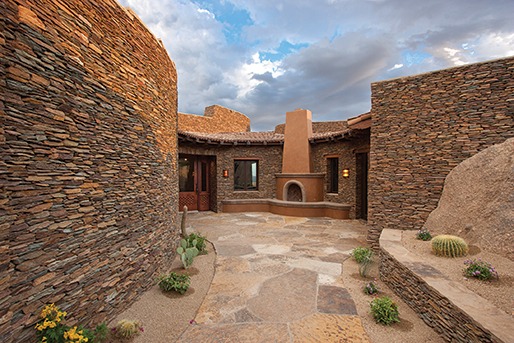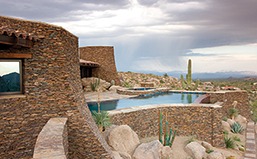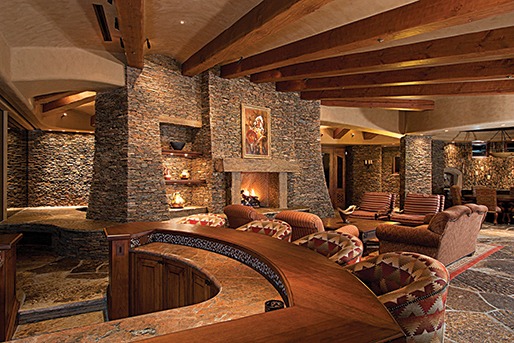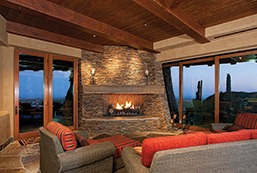November 2014
Natural Stone
Natural Bond: Mortar, Natural Stone and the Mason

The Sonoran Desert is considered one of the hottest deserts in North America, but tucked into the rolling hills and dramatic scenery of north Scottsdale, Ariz., sits one of the coolest natural stone residences imaginable. Nestled into one of the many hillsides near the Desert Mountain golf community is a secluded, 12,000-square-foot private residence. It was designed to include a variety of indigenous, natural schist and granite stones to artfully combine the qualities of the surrounding desert.
The residence was designed by project architect Craig Brown of Craig E. Brown & Associates, Fountain Hills, Ariz. The masonry work, both vertical and horizontal, was installed by Sutter Masonry Inc., El Mirage, Ariz. The home is positioned at 3,500 feet above sea level to take full advantage of unlimited panoramic views of the neighboring mountains that serve as the backdrop for spectacular sunrises and sunsets.
According to Brown, who worked closely with the owners, both of whom are general contractors, the site already contains its design. “The creative task of the artists, designers and architects was to make the invisible visible,” said Brown. “Using natural stone as the major exterior and interior material for walls, fireplaces, floor and patio decks, in combination with wood, stucco and copper, was the only choice to bring the manmade into this beautiful natural setting.”
 |
Utilizing the mountain’s solid granite and natural granite boulder outcroppings to compliment the home’s theme, it features curving walls that were designed to maximize the scenic views of the area.
“Natural schist stone was quarried in Mayer, Ariz., into six-inch-thick veneer, blending together various natural colors,” said Brown. “It was dry stacked and laid horizontally for the walls and fireplaces, and then switched to vertical on the walls in the main dining room. Natural stone is also laid in random patterns for the floors, patio decks and stairways.
One of the highlights of the home is its exterior and interior theme, where schist stones were laid in such a manner that they almost look staggered to create a rugged, imperfect look. Thousands upon thousands of schist stones were custom cut and fitted to adhere to the inside and outside of the structure, utilizing 450 3,000-pound bulk bags – or 1.3 million pounds – of SPEC MIX’s Colored Building Stone Mortar.
 “This residence is one of my favorite natural stone projects we’ve been privileged to build,” said Mike Sutter, CEO of Sutter Masonry Inc. “Aside from the overall size of the project, the two most challenging aspects of the installation were the amount of stone used – both inside and outside – and applying the mortar and stone on the curved walls, arches and slopes.”
“This residence is one of my favorite natural stone projects we’ve been privileged to build,” said Mike Sutter, CEO of Sutter Masonry Inc. “Aside from the overall size of the project, the two most challenging aspects of the installation were the amount of stone used – both inside and outside – and applying the mortar and stone on the curved walls, arches and slopes.”
Sutter went on to describe his masons’ technique: “They used a full depth mortar bed of colored SPEC MIX Building Stone Mortar to set the stone, resulting in a thin bed joint between the units, which perfectly matched the specified color and the stone.”
Sutter’s brother and project superintendent, Jack, has worked on numerous natural stone custom residential projects in the Phoenix valley. He is a major advocate of SPEC MIX mortars. “I use SPEC MIX Building Stone Mortar on all of my full-depth stone jobs,” he said. “You getter better production with this mortar, and it cleans off the face of the natural stone better. If we use regular Portland and lime mixes, there can be excessive lime stains left on the face of the stone. With SPEC MIX Building Stone Mortar we don’t get that.”
 |
SPEC MIX Building Stone Mortar is the only pre-blended, specially formulated mortar produced for stone masons building full-depth natural stone walls. The product is engineered to match the specific properties of each stone to increase the mortar-to-stone bond strength and maximize a mason’s productivity.
With all mix constituents and pigment pre-weighed and bagged, Sutter’s jobsite laborer simply loaded the SPEC MIX G7000 Silo System with 3,000-pound bulk bags. With the silo full, either the laborer or lift operator was able to charge the mortar mixer and add the appropriate water demand for the desired consistency of the masons installing the stone. In the case of the schist stone, Sutter Masonry used a thick mortar bed to place the stone in both horizontal and vertical (soldier) fashion, as specified by Brown.
Jack speaks to the company’s earlier years: “Back in the old days, mixing the bags of cement and lime together with sand was never consistent. Now with the SPEC MIX products especially their colored mortars, every batch is the same, which is better for the guys to work with and we deliver a better masonry building to the owner.”
In all, the project took three years to complete, with close to 30,000 man hours of work. The concrete masonry crew that dealt with the concrete base work on the home consisted of 25 masons and mason tenders. The crew worked more than 7,000 collaborative hours on the home. The stone crew worked on all interior and exterior stone applications, and consisted of 31 masons and mason tenders who worked more than 21,000 collaborative hours to make the house a dream come true for its owners.
Sutter Masonry also builds countless projects whereby the architect has selected natural, thin cut stone applied over concrete or CMU to achieve a certain aesthetic appeal. “On natural, thin cut stone veneer jobs, my crews use nothing but SPEC MIX Polymer Modified Stone Veneer Mortar – I love the product,” said Sutter. “Our daily production with this mortar is incredible; once the stone makes contact with the mortar on the wall, it sticks and you move on to the next stone.”
|
Ask The Expert |
 Cleaning natural stone can be a touchy subject for masons. You want a clean, beautiful surface without sacrificing the stone material’s natural state and condition.To learn more, Masonry consulted with natural stone cleaning expert Jim Lucas, who represents PROSOCO, Mortar Net USA, Cortec Corp. and JE Tomes. Lucas has nearly 45 years of experience as an independent manufacturer representative in the industry. He has been a member of the Construction Specifications Institute since 1970. He also is a member of the Association of Licensed Architects, the International Concrete Repair Institute, the Wisconsin Chapter of the American Concrete Institute, and the Wisconsin Masonry Alliance. Cleaning natural stone can be a touchy subject for masons. You want a clean, beautiful surface without sacrificing the stone material’s natural state and condition.To learn more, Masonry consulted with natural stone cleaning expert Jim Lucas, who represents PROSOCO, Mortar Net USA, Cortec Corp. and JE Tomes. Lucas has nearly 45 years of experience as an independent manufacturer representative in the industry. He has been a member of the Construction Specifications Institute since 1970. He also is a member of the Association of Licensed Architects, the International Concrete Repair Institute, the Wisconsin Chapter of the American Concrete Institute, and the Wisconsin Masonry Alliance.
Lucas’ awards include the CSI’s Brousseau Award and the AIA’s Chicago Chapter Distinguished Service Award. He has written articles addressing masonry cleaning, repointing and restoration for various industry magazines. He also is a speaker and AIA Learning Unit Provider for PROSOCO, Mortar Net Solutions and Cortec Corp. Following is what he had to say. Masonry: Discuss different cleaning considerations for varying types of natural stone, including limestone, marble, granite, cultured stone. Jim Lucas: The first step in cleaning stone is to identify the stone. Natural Stone can be silica based or calcium based. The silica stones are granite, sandstone (including bluestone), slate, gneiss, schist and basalt. The calcium-based stones include limestone, travertine and marble. From a cleaning standpoint, the main difference is that the silica stones are insensitive to most acids, and the calcium-based stones are sensitive to most acids. The fastest way to identify them is with a drop of hydrochloric (or muriatic) acid. If it fizzes, it is a sensitive stone. If it lies on the stone like water, it is an insensitive stone. Cleaners containing acids are often appropriate for concrete pavers. Clay pavers can be treated like silica based stone. Masonry: How important is determining pressure and volume for each project? What about accessories, like brush types? Also, talk about cleaning agents – when are they necessary? Lucas: Water pressure is of little importance in cleaning stone. Water volume is very important. I like to see a power washer being used but I want a fan tip and pressure less than 1,000 psi. Masonry: How is cleaning mortar from a newly finished natural stone project going to differ from cleaning older, stained natural stone? Lucas: The answer to this question is enough to fill a book. I can address the mortar issue easily enough, but stained, older stone is much more difficult to address. Not only do you need to identify the stone, but you need some info about the stain. Some common ones are tire marks, sealer blush (turning milky white), algae, moss, mold, mildew, leaf stains (especially oak trees), insect fecal matter (often called “tree sap”), oil stains from food, body oils or automotive fluids, deicing salt stains (commonly called efflorescence), hard water deposits (improperly aimed sprinklers), smoke and exhaust. Then, you have the issue of water usage. If this is an interior application, we can’t use much water. Churches and office lobbies are typical. Finally, you have stains that are actually part of the stone. Indiana Limestone often has quarry sap stains. Ohio sandstone often has metallic oxidation staining in new stone. Bluestone often exhibits a rusty orange discoloration. Quarry sap must just disappear as the stone reaches equilibrium with the environment. Metallic stains in Ohio Sandstone are just part of the beauty of the stone. Orange stains on bluestone can be chemically reversed. |